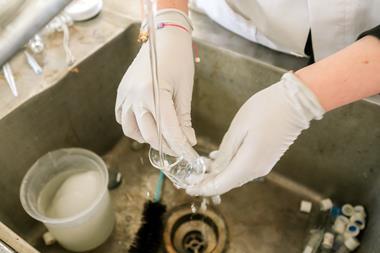New regulations mean labs will have to become greener - but the benefits could be financial as well as environmental
Tightening regulations will soon force university and college chemistry departments to reduce their energy and environmental impact, delegates at a meeting on The Sustainable Laboratory heard in London on 27 April. Alongside the green credentials, using fewer resources means spending less money - freeing up funds for science.
With the UK government having committed to an 80 per cent reduction in carbon emissions by 2050, a raft of new legislation will soon be driving universities to cut energy use in the lab, said Peter James, co-director of the Higher education environmental performance improvement programme (Heepi). However, departments which respond quickly to green their labs could potentially increase their income - as well as their prestige - as league tables and financial incentive schemes are introduced.
One such regulation is the carbon reduction commitment (CRC), which is expected to impact over 100 of the UK’s largest further and higher education institutions, according to Heepi. Each participant pays for the carbon credits for the energy they are expected to use, with the money returned to participants based on their position on an energy league table. Organisations performing well will receive more funds back than they put in, while high energy users will get back less.
In the hood
However, in order to cut the carbon emissions, departments will need to reverse the trend towards ever more energy-intensive labs. A recent Heepi benchmarking study revealed that, until recently at least, new or refurbished labs tended to consume far more power than the older labs they replaced. Newer labs typically had more fume hoods, and more powerful - and more energy-hungry - analytical equipment installed, demanding more powerful cooling systems to cope with the heat they produce. However, the most efficient labs used half the energy of the typical lab, says James - and there’s no reason why, with better design, more labs couldn’t be run more sustainably, he concludes.
It’s changes to regulations for fume hoods that could have the biggest impact on energy use in chemistry labs, James told Chemistry World. The new European standard, EN 14175, was introduced to improve user safety by testing hood performance in situ, replacing the current standard high ventilation rate which can result in eddies in air flow. However, lowering the hoods’ fan speeds has the inadvertent effect of significantly reducing energy use - by as much 40-50 per cent, James adds.
In the mean time, changing lab user behaviour can significantly improve sustainability, Allen Doyle, sustainability manager at the University of California, Davis, US, told delegates. Doyle’s studies have shown that closing the sash on fume hoods can save thousands of dollars a year, not only as the fume hood used less power but because it cuts the amount of heated / cooled air that they draw up.
Doyle admitted that changing users’ behaviour can be difficult, adding that retro-fitting systems that automatically close the hood’s sash when not in use can pay for themselves in saved energy costs within a couple of years. However, students should be trained in lab sustainability as part of their education, in the same way that they are trained in health and safety, said Steve Owens, Environmental Manager at the health Protection Agency’s Porton lab, UK.
Owens’ own findings stressed the importance of sub-metering - fitting each lab with its own power and water meters, to identify high users but also to spark competition between labs to rise up the table.
James agrees that resource monitoring will have to become increasingly detailed if the UK government is to achieve its ambitious carbon reduction targets. ’We’ve had an era of high level schemes, such at the CRC, but there has to come a stage where internal activities are monitored and audited in the same way,’ he says. ’We have the first example of that in the new building regulations, which demand regular efficiency inspections of cooling systems, and certainly within five to 10 years it’s possible that this may spread to all equipment using large amounts of power.’
James Mitchell Crow







No comments yet